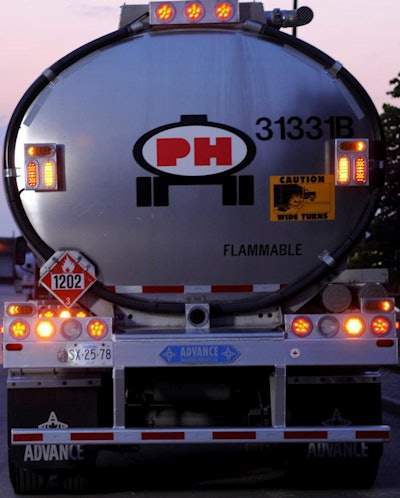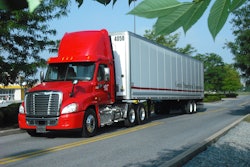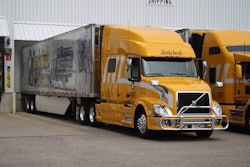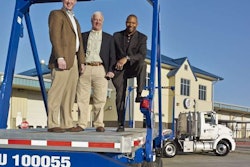 Paul’s Hauling improves the work environment for its drivers and gives the company a new level of confidence in their compliance.
Paul’s Hauling improves the work environment for its drivers and gives the company a new level of confidence in their compliance.Several years ago on a clear Sunday evening in July, a driver for Paul’s Hauling stopped for coffee after a delivery. After resuming the route, he came to an intersection. He turned right.
That lone decision proved fatal for a bicyclist standing too far out in the intersection. As the trailer rounded the corner, it pulled the bicyclist underneath.
The driver was not at fault, yet John Erik Albrechtsen firmly believes the accident could have been prevented because the driver should have turned left according to his route. Instead, he was in the wrong place at the wrong time.
“You never want to be in that situation,” says Albrechtsen, operations manager for the Winnipeg, Manitoba-based fleet. “You never want to have to go talk to the family and see the devastation in their lives. That’s one thing we never want to do again.”
This event would not have happened today, he says, with the processes and technology Paul’s Hauling has put in place. The changes improved the work environment for drivers and have given the 300-truck company a new level of confidence that drivers are following its designated routes.
Accidents are complex events, but many of them result from a lack of driver awareness. A number of factors – including stress, complacency and distraction – cause drivers to lose sight of risks in their environment.
Paul’s Hauling has been able to raise awareness and enhance safety by providing drivers the information they need when they need it. The company now has virtually 100 percent route compliance from shipping point to destination – and all points in between. These goals have been met with an integrated process to reduce risk and streamline operations – a process Albrechtsen calls “journey management.”
Step by step
Paul’s Hauling transports petroleum products and specialized commodities throughout Canada from Ontario to the West Coast and into 21 northwestern U.S. states. In Canada, the fleet can gross up to 137,000 pounds using double trailers. Its average payload is 91,000 pounds.
As a hazardous materials transporter, Paul’s Hauling pays close attention to its route designs. The company has to meet high global performance standards for customers such as Exxon and Shell, and it also has a vested interest in the safety of its employees and the public. These commitments are reflected in the company’s tagline – “People. Service. Safety.”
“To continually improve, we want to be more effective for our customers and do it in a safe manner that enhances things for our drivers,” Albrechtsen says. “We want everybody, whether they are going home in their car or on a work task, to arrive safely.”
For years, Paul’s Hauling printed its routes and operational procedures for drivers. These instructions were put in binders that drivers carried in the cab. All of its routes were – and continue to be – vetted carefully prior to being assigned.
Its detailed route guides since have been converted from paper binders to a turn-by-turn onboard navigation system. Before taking this step, management had to improve the accuracy of the routes themselves. Because of incomplete mileage information, the company was coming up short in billing customers while paying drivers for actual miles driven and hours worked from shipping points to destinations.
In 2004, Paul’s Hauling implemented a commercial software package with the actual street-to-street mileages of its routes. Previously, it was using city-to-city mileages, which is the standard practice. Once the new software was in place, the company could work with customers to approve the mileages for its custom routes, as well as focus on monitoring driver compliance.
Those efforts have paid off. Today, the difference in the fleet’s actual miles versus its billed mileage is less than 1 percent – down from 8 percent.
“It takes a lot of effort to do that work,” Albrechtsen says. “We are building an infrastructure that our systems can support.”
The user experience
For the next evolution in journey management, Albrechtsen worked with three of the company’s technology providers to create an integrated navigation system and unified driver workflow. The process began with a truck-specific turn-by-turn navigation application installed on its in-cab computing and communications platform.
To optimize route compliance, the two technologies had to be integrated in the cab and to the company’s back-office applications. Today, when office load planners call up an order and route, they automatically can transmit the information to the truck. In the cab, the work tasks and route the driver sees is an exact replication of what the planner sees.
“There is not an error going somewhere it is not supposed to go,” Albrechtsen says.“It is all preplanned. We have already identified the risks in all of the areas. If a driver has five or six stops, he does not have to key all those places in.”
When a driver arrives at a stop, the in-cab display automatically presents the driver with instructions for access to and egress from the loading site, as well as a customized form to input data while loading and unloading.
As a petroleum hauler, the company’s drivers used to have a “dip book” in the cab to assist with gallon calculations; those calculations now are built into the software. As drivers enter information, it instantly is validated to prevent down-stream errors.
When the driver leaves a location, the display goes back into turn-by-turn navigation. With this workflow, Paul’s Hauling has removed distractions and stress from the driver’s work environment.
“You need to do everything you can for your most scarce resource – your driver – to make his environment as easy and as effective as possible,” Albrechtsen says. “If I can take all that text and all that information and put it into a graphical interface and I can see it in real time, then that is going to add value to me.”
Predictive insights
Journey management is risk management, Albrechtsen says, and as such it always will be a work in progress. One of the tools Paul’s Hauling has in development now will help to improve routing and driver safety by monitoring where risky driving behaviors are happening and determine why, he says.
The company currently uses an application that compares driver speeds to posted speed limits. Using this and other data sources, it is working with vendors to create “heat mapping” to show where and how often aggressive behaviors are occurring. In addition to speeding events, the heat maps will include inputs from the activation of a vehicle’s roll stability system and hard braking events.
The heat mapping will help management determine if risk is associated with the route, driver or both. The graphical tool will help managers quickly understand the magnitude of events and then drill down into the details and come up with solutions.
“If we have a lot of hard braking in a particular area, perhaps we have a route with a sharp corner,” Albrechtsen says.
In addition to heat mapping, Paul’s Hauling is starting to use other types of analytical tools to go through its data to predict risk and take preventive actions.
One example is the use of a commercial product designed to capture the personality traits of the company’s best drivers. With this product, it has a predictive index for certain characteristics of drivers to hire.
For all the work that Paul’s Hauling has put into journey management and safety in general, Albrechtsen says there is no silver bullet. Everything the company is doing is an incremental step.
“We continue to evolve,” he says. “The technologies help us be more effective in driving our results.”











